Chishti Saints of Choa
“Choa is known for the shrines of the Chishti saints, who were primarily from the Qazi family of the Mughal Kasar tribe.”
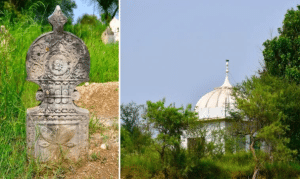
Choa is a historic village located 33 kilometers west of Chakwal city. This village is famous for its historic grand mosque, mansions, shrines, and the well known as ‘Da Darza’. Most of the mansions have either disappeared or lost their originality.
The grand mosque is the most impressive structure in the village, known for its wooden doors, roofs, and columns. Such decorative carved doors and columns are not seen in any other village in the Chakwal district. However, carved wooden doors can be seen in the mosques of Saral, Ranjha, Fam Kasar, and others, but not the magnificent carved columns. The mosque was built when the village was founded and was constructed with the financial support of the villagers.
In addition to the grand mosque, Choa is also famous for the shrines of the Chishti saints, who were primarily from the Qazi family of the Mughal Kasar tribe. According to Qazi Muhammad Farooq of Choa, who now lives in Rawalpindi, the forefathers of the Choa Qazi family were Baba Musa, who was the grandson of Baba Choli/Choli, after whom Choa was named. There were three brothers in the Kasar tribe: Baba Bhago, who founded Bhagwal; Baba Karso, the founder of Karsal; and Baba Chooli, the founder of Choa.
The Qazi family of Choa produced many renowned scholars, saints, and Sufis. One of the most notable Chishti saints of Choa was Qazi Ghulam Nabi, who was the deputy of Khawaja Shamsuddin Sialvi, known as Pir Sial (1883), who himself was the deputy of Shah Muhammad Suleiman, known as Pir Pathan (1850). It is known from the ‘History of Chishti Saints’ by Khaliq Ahmed Nizami (1953) that Shah Muhammad Suleiman Tonsvi had 70 notable deputies (Khalifas) and his deputy, Khawaja Shamsuddin Sialvi, had 35 deputies.
The shrine of Qazi Ghulam Nabi Chishti in Choa village:
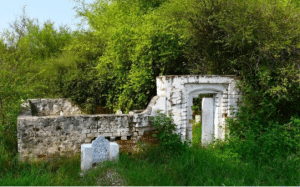
The shrine of Qazi Ghulam Nabi Chishti in Choa village
Qazi Ghulam Nabi Chishti was born in the village of Choa. According to Haji Muhammad Murid Ahmad Chishti in “Fawz ul-Muqal fi Khalifa Peer Sial” (1997:506), Qazi Ghulam Nabi’s father, Qazi Ghulam Murtaza, was a scholar and saint from the Mughal Kasar tribe. He received his early religious education from his father and later went to Delhi for further studies. There, he was taught under the supervision of the renowned Islamic scholar Sadrudin Khan Azurdah Dehlvi (died 1868). After completing his education, he returned to his ancestral village, Choa.
Later, at the request of his student Qazi Abdul Baqi Karsalvi, he started teaching in a madrasah in the village of Karsal in Chakwal. Qazi Abdul Baqi Karsalvi was a student of Qazi Ghulam Nabi Chishti. It is known from “Fawz ul-Muqal fi Khalifa Peer Sial” by Haji Muhammad Murid Ahmad Chishti (1997:621) that Qazi Abdul Baqi Karsalvi was initiated into the Chishtiya order by Khawaja Shamsuddin Sialvi. Akhtar Rahi, the author of “Tarai Ulama-e-Punjab Volume 1” (1998:80), writes that Qazi Abdul Baqi Karsalvi was the son of the distinguished scholar Qazi Ahmad Din Karsalvi, who was a student of Shah Abdul Aziz Muhaddith Dehlvi.
Qazi Ghulam Nabi Chishti also received his spiritual cap (dastar bandi) from Khawaja Shamsuddin Sialvi, known as Peer Sial. He spent his entire life teaching in Karsal village. After the death of Qazi Abdul Baqi Karsalvi on the 24th of Ramadan 1337/June 1919, Qazi Ghulam Nabi Chishti continued teaching in a madrasah in Karsal village.
Many scholars, including Qazi Abdul Baqi Karsalvi, Maulana Muhammad Wali Ullah, Maulana Muhammad Jafar Chishti, Maulana Qazi Abdul Rahman, and Maulana Noor Ahmad Chishti Mirowi, received their education under his supervision. Maulana Muhammad Jafar Chishti was born in Choa. He was a teacher who taught in Mukhadd, Chura Sharif, and other places. He resided in Yekh Sharif in the Mandi Bahauddin district, where he passed away and was buried.
The grave of Qazi Ghulam Nabi Chishti is in Choa village.
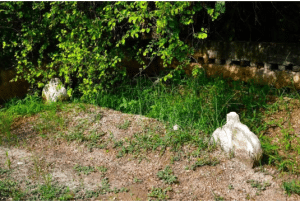
The grave of Qazi Ghulam Nabi Chishti is in Choa village.
Qazi Ghulam Nabi Chishti passed away on 11th Rabi-ul-Awwal 1343/October 1924, and his burial took place in Choa. His shrine (dargah) is located on Choa Karsal Road, north of the village. Inside the boundary of Qazi Ghulam Nabi Chishti’s shrine, there are three graves. The central grave is that of Qazi Ghulam Nabi Chishti, surrounded by the graves of Hafiz Ghulam Rasool and Maulana Zaman. There are several beautifully carved stone graves near his shrine in the Choa cemetery.
Another famous Chishti saint from Choa, Khawaja Ahmad Noor, son of Qazi Muhammad Shah, received his education under the supervision of Qazi Ghulam Nabi Chishti in a madrasah in Karsal village. He later became the deputy of Khawaja Ahmad Mirowi, whose shrine is located in Mira Sharif in the Pindi Gheb tehsil of Attock. According to “Faiza-i-Mirowi” by Khawaja Muhammad Fakhrudin Mirowi (2006:43), Khawaja Ahmad Mirowi’s uncle, Khawaja Shah Muhammad Suleiman Tonsvi, was a disciple who often visited him in Tonse Sharif. On one occasion, Khawaja Ahmad Mirowi also went to the khanqah of Shah Muhammad Suleiman Tonsvi with his uncle Ali Khan. It is said that Khawaja Shah Suleiman recognized Khawaja Ahmad Mirowi as his khalifa (successor) when he was 15 years old.
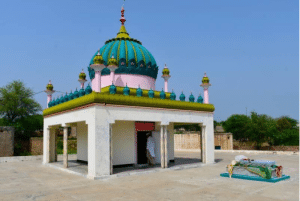
Shrine of Khawaja Ahmad Noor Chishti Mairvi
Khwaja Ahmad Noor Chishti Mairvi spent his entire life preaching the ideas and theories of his spiritual guide, Khwaja Ahmad Mairvi. After receiving the dastarbandi (ceremonial headgear) from Khwaja Ahmad Mairvi, Khwaja Ahmad Noor Chishti Mairvi returned to his village where he propagated the Chishtiyya Mairviyya order. According to “Badr Munir” by Maulana Muhammad Usman Ghani Chishti Mairvi (1986:45), a local landlord in Chawli gave Khwaja Ahmad Noor Chishti Mairvi a piece of land where he built a mosque and began teaching students. Furthermore, Mufti Muhammad Usman Ghani Chishti Razvi Mairvi mentioned that the distinguished religious scholar Allama Muhammad Abdul Ghafur Hazarvi (1909-1970) met Khwaja Ahmad Noor three times in Chawli village, indicating how learned Khwaja Ahmad Noor Mairvi was. He passed away in 1955 and was buried next to the mosque he had built during his lifetime. One of his followers constructed a domed structure over his grave, and his followers also decorated Khwaja Ahmad Noor Chishti Mairvi’s mosque.
Besides Khwaja Ahmad Noor’s shrine, the shrine of another deputy of Khwaja Ahmad Mairvi, Pir Habib Shah Gilani, is also located near Chawli village, about 3 kilometers west in Malwal village. Maulana Muhammad Usman Ghani Chishti Razvi Mairvi (1986:47) in his book “Badr Munir” states that after receiving the khirqa (a symbolic Sufi garment) from his spiritual guide, Khwaja Ahmad Mairvi, Pir Habib Shah settled on a hill near Chawli where he spent most of his time in prayer. He was also responsible for overseeing the community kitchen and ensuring water supply at Khwaja Ahmad Mairvi’s court, a duty he performed for many years.
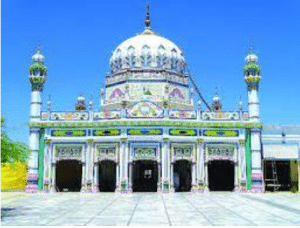
Shrine of Khawaja Ahmad Mairvi
Mufti Muhammad Usman Ghani Chishti Mairvi was another renowned Sufi elder and scholar from Chawli village. He was a religious scholar and the author of several books, continuing the legacy of his family’s Chishti saints. He also owned a good library. The scholars from Karsal, Qazi Ahmaduddin and his son Qazi Abdul Baqi, also had a good collection of books on religious studies and other topics.
According to “Anwar Sial” by Haji Muhammad Murid Ahmad Chishti (2008:206), Mufti Muhammad Usman Ghani Chishti Mairvi was born in Chawli in 1913 and received his early education from his father Qazi Mian Muhammad, Mufti Ata Muhammad Ratavi, and Maulana Wali Muhammad of Chawli. Later, following the guidance of Mufti Ata Muhammad Ratavi (died 1957), he went to Rampur for further studies. He also studied under the prominent scholar Maulana Muhammad Naeemuddin Moradabadi (died 1948). He was inducted into the Chishtiyya Mairviyya order by Hazrat Khwaja Ahmad Mairvi’s first successor, Hazoor Sanvi (died 1931).
Maulana Muhammad Usman Ghani Chishti Mairvi authored nine books. He passed away in 1998 and was buried in Chawli cemetery. His shrine is located east of Chawli Bhagowal Road. He had three sons. The graves of two of his sons, Maulvi Maqbool Ghani and Qazi Maqsood Ghani, are located inside the compound walls, while the grave of his third son, Qazi Masood Ghani, is located outside the walls. The graves of his father, Qazi Mian Muhammad (died 1967), and his uncle Qazi Ghulam Muhammad (died 1945) are located to the northwest of his enclosure.
There were two individuals named Qazi Ghulam Muhammad. The first, Qazi Ghulam Muhammad (died 1945) from Jhelum’s tehsil Pind Dadan Khan in Lillah Sharif, was a deputy to Khwaja Ghulam Nabi (died 1889). According to “Tazkirah Ulema Ahlus Sunnah District Chakwal” by Allama Hafiz Abdul Halim Naqshbandi, Qazi Ghulam Muhammad was a deputy to Khwaja Ghulam Nabi (died 1889) and taught in several madrassas including Kot Sarang, Dhok Wark, and Munday village. The second Qazi Ghulam Muhammad, who was the uncle of Abdul Rahman Numberdar, was the first to start Friday prayers at the Jami Mosque of Chawli village.
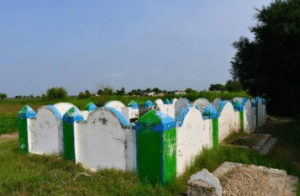
Mufti Muhammad Usman Ghani Chishti Mairvi
Many other members of the Qazi family from Chakwal and other districts of Punjab have played significant roles in providing religious education in various villages. The list of Qazi scholars and saints from the Chishti and Naqshbandi orders is extensive. Mufti Qazi Saeed (died 1978), a renowned Islamic scholar from Chawli and son of Qazi Idris, was a disciple of Maulana Shabbir Ahmad Usmani (1887-1949). He authored several books and passed away in the village of Miani in Sargodha district, where he was buried.
The saints, Sufis, and scholars of the Qazi family from Chawli preached in Punjab and other areas. Some left Chawli for preaching and settled elsewhere, while others continued their spiritual mentors’ legacy and stayed in their village.

